The Do’s and Don’ts of Accent Walls

The Do’s and Don’ts of Accent Walls
When redecorating your home, accent walls are an interesting feature that will most likely cross your mind as it is so common in many design magazines and professionally designed homes. The trend of accent walls has become popular for good reason. It is a simple way to spruce up an otherwise plain room and can allow you to experiment with colors and patterns that would otherwise be too much for an entire room. It can also be used as a way to test the waters for painting more of your home in a similar color before really committing to the color or pattern.
There is a great deal of creative freedom associated with accent walls, but that doesn’t mean that there are no rules to follow when you are hoping to have a positive outcome after all your planning. Below are a few key do’s and don’ts to consider when deciding to dedicate a part of your home to an accent wall so that you can avoid common pitfalls and aim for the most professional results.
Where to Place an Accent Wall
There are a few key locations that naturally suit an accent wall. The most common choice for accent wall is the wall that touches the headboard of your bed. Often, this part of the room is the focal point and the bed can lead the eye towards to wall. By placing the accent wall at the same place as the focal point of the room, you can avoid creating a cluttered feeling if you chose a particularly bold color or a heavily patterned accent wall. It is never a good idea to have too many focal points in a room, especially when working with small rooms.
As an alternative, an accent wall in the bedroom can also be placed on the wall where your dresser is located. This works particularly well for large dressers that take up most of a room or are more of a focal point that the bed. If working with a child’s bedroom, there is more freedom to place the accent wall away from key pieces of furniture. Often, the area of the room that has the child’s toys is a great place for an accent wall. Integrating the accent wall with a theme or colors from favorite toys is a nice idea, but keep in mind that the accent wall will lose its appeal quite quickly as the child ages if it is too targeted towards one theme.
Accent walls are also great additions to walls with fireplaces, divider walls of living rooms and in dining areas of a kitchen. However, be wary of adding an accent wall to a crowded kitchen. Accent walls are best in large kitchens that can benefit from having a defined eating area or to create the illusion of having a more defined dining area.
Where NOT to Place an Accent Wall
The biggest mistake that people make when including accent walls in their designs is adding them to spaces that already have too many design features. A wall with lots of doors, windows or cupboards should not be your first choice as an accent wall. Narrow hallways are also a poor decision, as the bright colors and busy patterns that are part of most accent walls will make a narrow hallway feel even more desperate for space. On the opposite end of the spectrum, choosing an overly large wall to accent in an open concept home can create the illusion that the room is much smaller than it really is. When dealing with open concept style homes, it is best to select a small section of wall rather than the entire wall.
Consider the design of the room around the accent wall. Placing an accent wall in one of the above suggested locations can still backfire when personal design choices overpower the wall itself. For example, adding an accent wall behind your headboard in your bedroom is a tasteful design choice as long as you don’t have heavily patterned bedsheets or brightly coloured pillows everywhere. You have to commit to having the accent wall be the focus of the space rather than your lamps, curtains or paintings. If you insist on keeping distracting design elements, be sure to keep them on the opposing side of the room from the accent wall.
To Choose Paint or Wallpaper?
When creating an accent wall, you should absolutely take advantage of the style to use bold patterns, interesting shapes and colors. You can go beyond what would be acceptable for an entire room, but do try to choose colors that complement each other and don’t go beyond three or four colors for one wall. When choosing intricate patterns, the masking and planning of how to paint the colors in a sensible sequence is a job best left to professionals. Nothing looks worse than an accent wall with crooked patterns or sloppy edges! Using wallpapers or paints are both great tools at your disposal, but don’t forget that there are other options to create an accent wall. Don’t be afraid to experiment with tiles, wood or stone.
If you are looking for a Naples, FL interior painter or just want to learn more about interior painting and accent walls, then give us a call. We’re ready to answer all of your questions. You can contact us here or you can call us directly at 239.600.1418
Before & After Photos
See before and after pictures of our work located in our photo gallery.
See Our Work HereServices We Offer
Web Design & SEO by DE Web Designs

